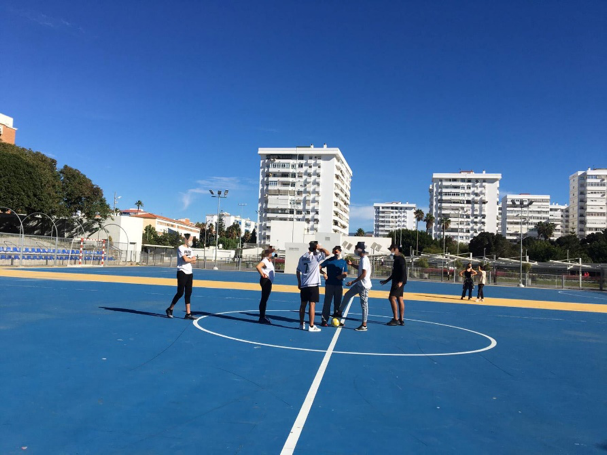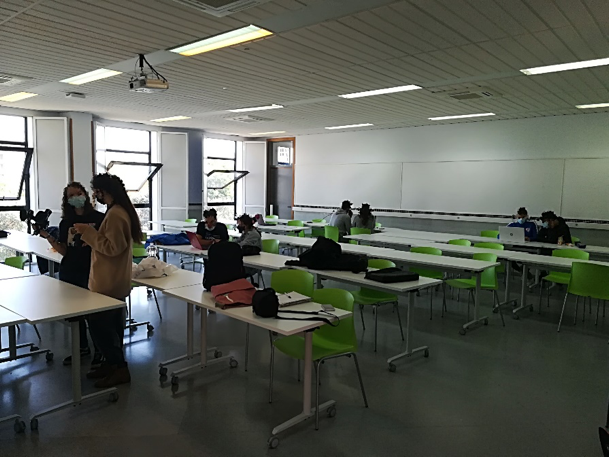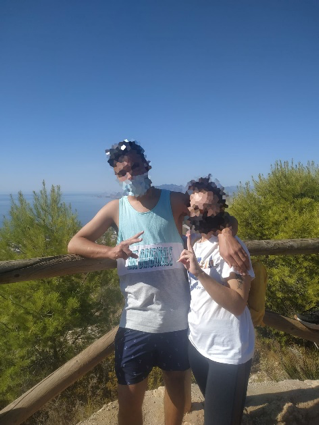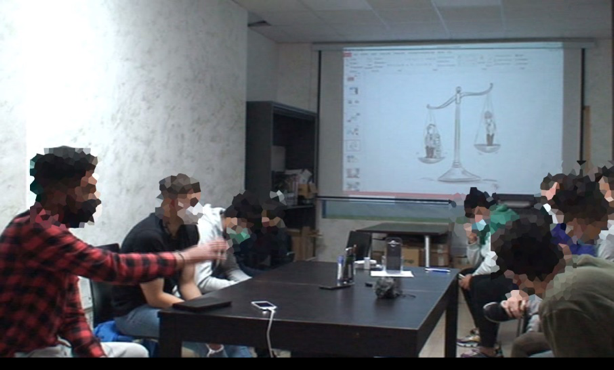
The LEMA project has been formed in Málaga (Spain) by two entities: the University of Málaga (UMA) and the Moroccan Association for the Integration of Immigrants.
On the occasion of the ‘Urban Action’ of the project, in that country they worked with young immigrants between 18 and 20 years old. They were young people from Morocco who migrated alone from their country when they were still under eighteen. Once detected in Spain by the corresponding entities and after verifying their status as ‘Unaccompanied Foreign Minors’ (UFM), the public system took care of them. This system activated the existing child protection mechanisms which, among other things, provided them with shelter, food and minimal living conditions, educated them and tried to help them to build the life they longed for in a dignified manner and within the channels of legality. All this until they were 18 years old.
The problem was that once they reached that age, all that support was taken away from them and they were left in a situation of risk that threatened to ruin all the work done up to that point. They were left in a situation of vulnerability to numerous and diverse threats. They had to survive with few resources and in an unnatural environment. Let’s not forget that they had no family around them, they were in a foreign country, in a culture different from their own, with a linguistic handicap, without a home or economic income, etc.
Occasionally, the Moroccan Association had a programme for this group (called EXYI: Ex–Protected Young Immigrants). The young people who have participated in the LEMA project in Malaga (Spain) are part of the EXYI program of the Moroccan Association. Specifically, we worked with a group of approximately 10 young people, all male, whose members have varied over the course of the project. The mobility of these young people is part of their reality and throughout the time we have been working with them there have been several boys who have left to other places trying to find other life opportunities, while there have been new additions who have been joining the project.
The main aim of the LEMA project guided the action carried out in Malaga (Spain). Within this framework, the emphasis was placed on the socio-educational action with the young people. Specifically, a process of socio-educational accompaniment was articulated around an analytical action, which was intended to be empowering and inclusive. In the following section, the socio-pedagogical foundations of this process will be explained and the main actions that were carried out to materialize it will be shown. In essence, the task consisted of analyzing, together with the young people, their life stories, focusing on resilience. Resilience is here understood from an environmental point of view (not only individualistic), intersectional and longitudinal (as a result of the confluence of numerous and varied factors in the course of a lifetime).
The socio-educational foundations that have underpinned the socio-educational action with young people in Málaga (Spain) are outlined below. As these foundations are made explicit, the main dynamics that materialized the work with these young people will be described.
The intervention model used is the result of the combination of different perspectives. Perspectives that the different members of LEMA in Málaga (Spain) have applied in other projects (individually and jointly, and from complementary approaches) with children and young people at social risk (i.e., a population with similar characteristics), with good results. These perspectives have been defined by virtue of the analysis of these experiences. So much so that this rationale is distilled, fundamentally, from the core ideas of the references that appear at the end of this section, which are publications elaborated by the members of the LEMA team in Málaga (Spain). The LEMA project has provided the opportunity to combine the strong points of these perspectives and to improve the aspects that needed, in order to make a qualitative leap in the construction of a more complete and holistic model that combines these complementary approaches and makes possible a more far-reaching socio-educational action. By virtue of this, a multi-approach model has been assembled combining the following perspectives: environmental-humanist, empowering-critical and inclusive.


The first approach taken into consideration is the environmental-humanistic one. The creation of an adequate environment to carry out the socio-educational work to be implemented was considered fundamental. Setting such an environment required the conjugation of various elements, one of the nuclear ones being the relationships and bonds between the different members of the experience (young people, volunteers, educators and researchers).
With this in mind, it was thought that the work to be carried out with the children should be impregnated with a recreational character. All the sessions had to begin or be articulated, in a general way, through social, playful, sporting, cultural or similar activities. These activities, which were agreed with the young people or were explicitly requested by them, were interesting and motivating for them and provided a climate conducive to weaving connections between all the participants.
Connections that, although invisible, tried to be forged with the most solid raw material: trust, which, together with the attachment that was also generated through the different dynamics that were carried out, pursued the development of bonds between the different members of the project (Bowlby, 19761). Hence, not only the activity was considered important, but, above all, the moments of interaction around it.


These bonds were singular in each case, but little by little they became stronger and a web of relationships was woven around the project that, in addition to representing a new social circle for the young people, emerged as a support network for them, some even likening it to a family:
“I feel good [about the project] because now we are as a family, now everyone has one more family.“
Focus group of youth from the Moroccan Association.
The essence of such an environment was humanistic. The basic premises that permeated it were: protection, equity, respect, horizontality, dialogue and freedom. In addition, a work system based on personalized attention was designed. Initially, each young person was asked to draw up a ‘Lifeline’. Taking into account that it was a strange task for them and that the level of abstraction of some of them was limited, a system of work in pairs was articulated. Each young person from the Moroccan Association would be accompanied by a volunteer, an educator or a researcher. The volunteers were university students, the educators were professionals of the Moroccan Association and the researchers belonged to the University of Malaga. They all attended each of the sessions that took place, participated in the recreational activities at the beginning of each day and then worked alone with the young person with whom they had been paired. This allowed for a more humane and individualized treatment between the members of each pair, as they got to know each other in a more personal and intimate way, and the establishment of more consistent bonds.



The second approach from which we have worked has been the empowering-critical one. This approach was articulated through the intervention model called: socio-educational accompaniment, which is based on walking with the other person to provide support and guidance in the course of that walk. The objective of this model is to contribute to the development of independent people with sufficient criteria to develop autonomously in their environment.
In the case of LEMA Málaga (Spain), we walked with the young people of the Moroccan Association in the sessions that were held weekly for the project, although we were also at their side in facing other vicissitudes (individual and circumstantial) that were considered necessary, such as, for example, ‘overcoming a bump in the road’ or simply spending free time together. In this sense, the accompaniment was designed to fulfill the tasks set, but above all to support them, because the aim was for them to acquire confidence and the necessary tools to be able to fly on their own.
“I like this project because on weekends, for example, we go for a coffee and watch football and we don’t feel alone in the house. We don’t have that day when you run out of patience and you feel bad. So that this doesn’t happen, thanks to the project we are going to play, to have fun, to watch football, to have a coffee”
Focus group of youth from the Moroccan Association.
In relation to the task of analysis that had to be done on the basis of the ‘Lifelines’ of the young people, they were guided in their elaboration, offering them guidance and advice, at the same time that they were asked doubts and questions that made them reflect on the matter. The personalized work that was done with each one of them culminated in a collective Focus Group in which they discussed together, in a reasoned way, the most substantive aspects that had emerged individually. All this to make them think about their reality. Therefore, the accompaniment was also educational, because it aimed to develop arguments that could help them to understand, in a more comprehensive way, the complexity of the situation in which they found themselves, to glimpse ways of solution and to explore resilient strategies. All of which was developed from a critical perspective that sought equal opportunities and social justice (Freire, 19762; Giroux, 19833), since, on the one hand, it sought to counteract the difficulties they had to face and, on the other, the transformation of the structures and mechanisms that prevented their development (the advancement of the members of this group).


The third approach, attention to diversity and inclusion, was developed in parallel as a consequence of all of the above. The approach is that the critical empowerment of members of a minority group at risk, through the humanist environment, also aims to contribute to their full development. In other words, from the above perspectives, it was also about laying the foundations so that these people could develop in all their dimensions and in all areas of life.
Taking into account that two of the three basic human needs (Maslow, 19754), physiological and protection, of the young people were minimally covered by the program of attention to EXYI of the Moroccan Association. From an inclusive perspective a mechanism was articulated to contribute to the development of the third of them: affiliation-belonging (which is the one that completes the basic level of survival) and to complete the second (just mentioned), creating an environment of greater security for the young people.
The involvement of the volunteers in the project (a group of young university students of the same age as the young people of the Moroccan Association) made possible to generate this environment and to broaden the relationship system of the latter. It gave them the opportunity to relate to people outside the Moroccan Association (natives from Málaga) in an environment of trust, which was pleasant for them, generating roots and making them see that they were fulfilling their migratory dream, giving them the strength to continue moving forward.
“For me it is important because there are not many people who volunteer to be with us, as we said before, we need to be trusted, there are many people who are Spanish who do not trust us, but these people do.”
Focus group of youth from the Moroccan Association.
The following are some of the references published by LEMA members in Spain that support the rationale just outlined:
Ruiz-Román, C. y Herrera-Pastor, D. (2020). La investigación de la Resiliencia y el Acompañamiento Socioeducativo: situación, limitaciones y posibilidades desde la mirada de la desventaja social [Researching on resilience and socio-educational accompaniment: Situation, limits and possibilities from social disadvantage]. En E.S. Vila Merino e I. Grana Gil (coords.). Investigación educativa y cambio social (211–226). Barcelona: Octaedro.
Herrera, D., Juárez, J. y Ruíz-Román, C. (2020). Collaborative leadership to subvert marginalisation. The workings of a socio-educational network in Los Asperones, Spain. School Leadership & Management, Vol. 40, 2–3, 203–220. DOI: https://doi.org/10.1080/13632434.2019.1699525
Ruiz-Román, C., Juárez, J. y Molina, L. (2020). Facing adversity together by looking beyond ability: an approach to resilience among at-risk children and youth. European Journal of Social Work, 23(2), 315–326. DOI: https://doi.org/10.1080/13691457.2019.1570084
Herrera-Pastor, D., Padilla-Carmona, M.T., & González-Monteagudo, J. (2020). Acompañamiento sociopedagógico, holismo y longitudinalidad: Claves de una buena práctica con un menor infractor [Socio-pedagogical accompaniment, holism and longitudinality: Keys from a good practice with a young offender], Vol. 22 (1), 62–74. Revista Fuentes. DOI: https://doi.org/10.12795/revistafuentes.2020.v22.i1.05.
Delgado, P., Bernedo, I., Carvalho, J., Salas, M. y García-Marín, M. A. (2019). Foster Carers’ Perspectives about Contact in Portugal and Spain. International Journal of Social Science Studies 7(6), 145–153. DOI: https://doi.org/10.11114/ijsss.v7i6.4502
Ruiz-Román, C., Molina, L. y Alcaide, R. (2019). We have a common goal: Support Networks for the educational and social development of Children in Disadvantaged Areas. British Journal of Social Work. 49 (6), 1658–1676. DOI: https://doi.org/10.1093/bjsw/bcz063
Herrera Pastor, D., Soler García, C. y Mancila, I. (2019). Interculturalidad Crítica, Teoría Sociolingüística e igualdad de oportunidades. La extraordinaria historia de un menor infractor [Critical Interculturality, Sociolinguistic Theory and Equity. The extraordinary story of a juvenile offender]. Revista Tendencias Pedagógicas, 33, 69–82. DOI: https://doi.org/10.15366/tp2019.33.006
Fuentes, M. J., Bernedo, I., Salas, M. D. y García-Martín, M. Á. (2019). What do foster families and social workers think about children’s contact with birth parents? A focus group analysis. International Social Work 62(5), 1416–1430. DOI: https://doi.org/10.1177/0020872818775475
Ruiz-Román, C. y Rascón, M.T. (2017) Between two shores: A multiple case study on the crisis of values and educational practices in Moroccan immigrant families in Andalusia, Spain. Children’s Geographies, 15 (2), 177 – 192. DOI: https://doi.org/10.1080/14733285.2016.1214683
Herrera-Pastor, D. y De Oña-Cots, J.M. (2017). Personalizar la intervención educativa con menores en situación de riesgo es fundamental para su desarrollo, la igualdad de oportunidades y la justicia social [Personalizing educational intervention provides equality of opportunities to under eighteen at risk]. Revista Internacional de Educación para la Justicia Social, vol 6, nº 2, 149–165. https://doi.org/10.15366/riejs2017.6.2.009
Ruiz Román, C.; Calderón Almendros, I. y Juárez, J. (2017). La resiliencia como forma de resistir a la exclusión social: un análisis comparado de casos [Resilience as a way of resisting social exclusion: a comparative analysis of case studies]. Pedagogía Social. Revista Interuniversitaria, 29, 129 – 141. DOI: 10. SE7179/PSRI_2017.29.09
Herrera Pastor, D. y De Oña Cots, J.M. (2016). La importancia del ambiente de aprendizaje. Pedagogía ecológica en un centro de menores [The relevance of the learning environment. Ecological education in a detention centre]. Revista Fuentes, 18 (1), 77–90. DOI: http://dx.doi.org/10.12795/revistafuentes.2016.18.1.05
Bernedo, I. M., Ruiz, C., Lino, R. y Juarez, J. (2019). Situación
educativa y sociolaboral de familias en exclusión social en Málaga. En J. A. Marín-Marín, G. Gómez-García, M. R. Navajas-Parejo, y M. N.
Campos-Soto (Eds.), Inclusión, Tecnología y Sociedad: investigación e
innovación en educación (pp. 1328–1341). Editorial Dykinson, S.L. (ISBN:
978–84-1324–491‑4).
García-Martín, M. A., Fuentes, M. J., Bernedo, I. M., y Salas, M. D.
(2019). The views of birth families regarding access visits in foster care. Journal of Social Work, 19(2), 173–191. doi: 10.1177/1468017318757399
Learn more
Bowlby, J. (1976). El vínculo afectivo [The emotional bond]. Buenos Aires: Paidós.
Contact: Ph.D., Associate Professor Ditte Tofteng, Copenhagen University College DITO@kp.dk